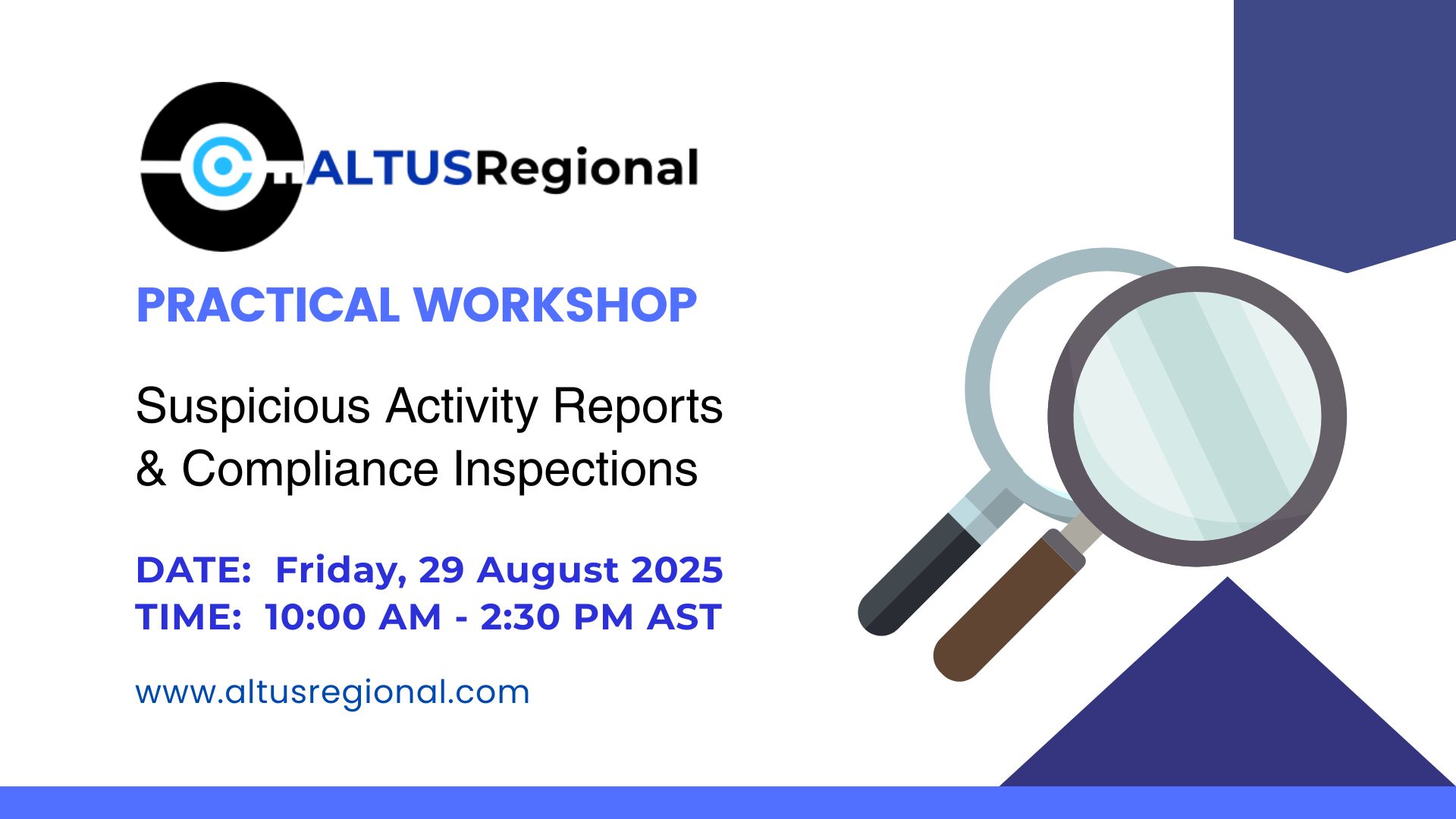Rethinking Financial Crime Supervision in the Algorithmic Age
- July 13, 2025
- Posted by: Natalie O. Sandiford, CAMS, LEC, LLM, MSc
- Categories: Corporate & Compliance, General

“In today’s rapidly changing AI powered era, regulation without evolution is regulation without impact- Natalie Sandiford, Managing Director, Altus Regional Consulting Solutions”
Artificial Intelligence is accelerating how illicit finance flows across borders, digital platforms, and institutional blind spots. As AI technologies grow more sophisticated, so too do the strategies employed by perpetrators seeking to circumvent financial crime prevention strategies. This changes the terrain for financial crime supervision across the Caribbean, making regulatory digital oversight critical for safeguarding financial ecosystems in the algorithmic age.
At the recent Altus Regional Panel Discussion on Implementing a Risk Based Approach, speakers explored the rise of AI-driven deception and how criminals exploit the same digital tools designed to promote financial system integrity. From deepfakes and synthetic identities to automated laundering through fintech rails, the threat has become faster, more scalable, and more difficult to detect. This article unpacks the dark side of innovation, outlines the technological and regulatory gaps currently hampering effective financial crime supervision, and proposes key responses for both regulators and institutions operating in high-risk and rapidly digitizing environments.
The AI-Enabled Evolution of Financial Crime
The integration of artificial intelligence into criminal ecosystems has dramatically altered the speed, scale, and sophistication of financial crime. Modern typologies now include algorithmically executed layering, synthetic identity generation, and automated transaction obfuscation. Perpetrators of financial crime are increasingly exploiting biometric spoofing, bot-driven document fabrication, and intelligent routing systems to bypass detection and mimic legitimate transaction behavior. These advances present profound oversight challenges regulators, eroding the effectiveness of static red-flag indicators, and operating beyond the reach of traditional supervisory mechanisms. As AI tools advance the architecture of financial crime, regulators must now rethink how threats are monitored, assessed, and disrupted across jurisdictions and financial ecosystems.
Key emerging typologies include:
Synthetic Identity Fraud
- Generative AI models can now craft realistic personas, complete with forged documents, AI-enhanced selfies, and deepfake voice responses. These profiles pass shallow onboarding checks and open the door to cross-border abuse.
Automated Money Mule Recruitment
- Chatbots impersonate recruiters or financial advisors, onboarding unwitting individuals into laundering networks. These personas respond naturally, build trust quickly, and operate 24/7 across jurisdictions.
Layering at Machine Speed
- AI-powered bots exploit open banking APIs and payment platforms to funnel funds through dozens of accounts in seconds, outpacing traditional transaction monitoring systems designed for batch analysis.
Deepfake Enabled Impersonation
-
Real-time voice cloning and image manipulation enable fraudsters to impersonate executives or regulators to authorize illicit wire transfers, mislead compliance officers, or misrepresent ownership stakes.
Manipulation of Verification Interfaces
- Criminals target automated eKYC systems, bypassing facial liveness detection using AI-spoofed biometrics, or submitting doctored documents that evade basic authenticity checks.
AI-Driven Sanctions Evasion
- AI is used to generate and manage vast networks of synthetic shell companies, each with distinct digital footprints. Algorithms optimize trade routes and customs codes to misclassify sanctioned goods or dual-use items.
The Regulatory Gap: Supervision in a Real-Time Risk Landscape
While the methods of financial crime have evolved with stunning speed, regulatory frameworks and supervisory practices often remain anchored in manual audits, periodic reviews, and reactive enforcement. This mismatch is creating a growing blind spot where AI-enhanced financial crime outpaces oversight models.
Key Challenges Facing Supervisors:
- Time Lag in Inspections Traditional supervisory models rely on annual or biennial compliance reviews, often retrospective in nature. But AI-driven financial crime adapts hourly, not yearly.
- Outdated Legislative References Many jurisdictions still define AML obligations in terms that do not encompass anticipate the use of synthetic identities, algorithmic layering, or dynamic onboarding fraud. Without modernized language, enforcement becomes interpretive and inconsistent.
- Limited Supervisory Technology (SupTech) Most regulators lack the internal tooling to ingest and analyze the same real-time data that criminal actors exploit. Without AI-augmented insight, supervisory bodies may miss emerging risks entirely.
- Capacity Gaps The skillsets required to supervise AI-enabled institutions now include data science, behavioral analytics, and digital forensics, and the emergence of these new technologies has increased the need for ongoing training and capacity building of staff within traditional compliance inspection units.
- Cross-Jurisdictional Fragmentation Criminals exploit regulatory silos. When each country defines, reports, and supervises AI-related threats differently, it opens windows for cross-border abuse.
While regulators are increasingly investing in digital supervisory tools, the rapid evolution of financial crime typologies and emerging technologies presents significant oversight challenges. FATF’s Opportunities and Challenges of New Technologies for AML/CFT (2021) acknowledges that many supervisory authorities lack the technical capacity, real-time data access, and legislative clarity needed to evaluate AI-enabled compliance systems effectively. While digital tools enhance detection and reporting capabilities, they also introduce new vulnerabilities and governance challenges. Pavlidis (2023) notes that supervisory bodies often struggle to assess the accuracy and reliability of machine learning models due to limited explainability and fragmented regulatory standards across jurisdictions. These gaps underscore the need for enhanced collaboration, digital capacity-building, and updated legal frameworks to ensure effective supervision in the algorithmic age.
Rethinking Supervision: Building Future-Proof Regulatory Responses
To counter the dynamic threats posed by AI-enhanced financial crime, regulatory bodies must evolve in legislation and inspection protocols, as well as in mindset, tools, and talent. The aim is to shift from reactive regulation to predictive oversight.
Invest in SupTech and Advanced Analytics
Supervisory Technology (SupTech), particularly AI-powered anomaly detection, network mapping, and behavioral analytics, allows regulators to:
- Detect emerging typologies faster
- Analyze unstructured data across sectors
- Conduct real-time or near-real-time surveillance of suspicious trends
This transition requires a strategic investment in cloud infrastructure, secure data-sharing protocols, and interoperable systems that can interface with both reporting entities and peer regulators.
Establish Innovation Sandboxes with Regulated Entities
Regulators should co-create Regulatory Sandboxes and Supervisory Labs, where institutions test AI-enabled compliance tools under controlled, monitored conditions. These environments:
- Promote transparency around emerging technologies
- Foster iterative feedback loops between private and public actors
- Encourage innovation that aligns with jurisdictional risk appetite
Such collaborative oversight models increase trust, improve scalability, and reduce regulatory lag.
Modernize Legal and Risk Taxonomies
AI-enabled threats demand a revision of how financial crime is defined and categorized. Regulators must:
- Update typology lists to include AI-enabled fraud, impersonation attacks, and synthetic ID misuse
- Redefine “unusual activity” thresholds to reflect behavioral deviations, not just transaction size
- Align with FATF and FSRB guidance on emerging technologies, ensuring clarity for institutions and courts alike
Build Digital Capacity Within Supervisory Teams
Regulatory resilience starts with people. Supervisory authorities must diversify hiring to include:
- Data scientists and forensic technologists
- Behavioral risk analysts who understand digital manipulation
- Legal technologists to translate AI risks into enforceable standards
Upskilling existing staff in AI fundamentals and cognitive bias awareness also strengthens supervisory judgment when evaluating automated controls or reviewing AI-generated red flags.
Enhance Cross-Border and Interagency Coordination
AI-enabled crimes are often borderless and agile. Supervisors must collaborate across:
- Financial Intelligence Units (FIUs)
- Cybercrime divisions
- Peer regulators via MoUs and data-sharing frameworks
The overarching goal of modern financial supervision is to fuse fragmented oversight mechanisms into coherent, responsive shields capable of adapting at the pace of evolving financial crime typologies. As institutions deploy increasingly complex technologies to deter illicit finance, regulatory bodies must respond in kind by modernizing their supervisory frameworks, enhancing interoperability, and cultivating rapid-response capacities across borders. FATF’s Guidance on Risk-Based Supervision (2021) emphasizes the necessity of dynamic, risk-adjusted oversight that integrates real-time data streams, cross-sector collaboration, and digital competencies to keep pace with emerging threats. In the algorithmic age, supervisory resilience hinges on the ability to unify siloed controls and build agile, intelligence-led systems that anticipate financial crime.
Risk-Based Financial Crime Supervision in the Age of Autonomy
Traditional supervision models anchored in periodic audits, prescriptive checklists, and static typologies were not built for the adaptive nature of AI-enabled financial crime. In today’s digitized environment, where synthetic identities, intelligent laundering schemes, and machine-speed deception evolve in real time, oversight must become predictive, not just responsive. Supervisory resilience in AI-driven financial environments depends on data-integrated governance, legal reform, and expanded technical capacity across oversight bodies. Regulatory bodies must embrace agile data ecosystems, cultivate interagency collaboration, and invest in talent capable of interrogating algorithmic decisions to remain effective in the face of emerging technologies and typologies. By reengineering supervision around dynamic risk, digital fluency, and behavioral insight, regulators can shift from chasing financial crime to anticipating it, thereby reasserting control over a landscape increasingly shaped by autonomy and acceleration.
Contribute an Article to our Blog
Past Events
Compliance Excellence in the Caribbean Webinar
-
January 30, 2025
-
11:30 am to 11:30 am
-
ONLINE
Implementing a Risk-Based Approach Workshop
-
June 27, 2025
-
One Day Workshop
-
ONLINE
- 1
- 2
Upcoming Events
Compliance Excellence in the Caribbean Webinar
-
January 30, 2025
-
11:30 am to 11:30 am
-
ONLINE
Implementing a Risk-Based Approach Workshop
-
June 27, 2025
-
One Day Workshop
-
ONLINE
SARs and Compliance Inspections Workshop
-
August 29, 2025
-
One Day Workshop
-
ONLINE
Sanctions Compliance Excellence in the Caribbean- Webinar
-
November 28, 2025
-
11:30 am to 11:30 am
-
ONLINE




